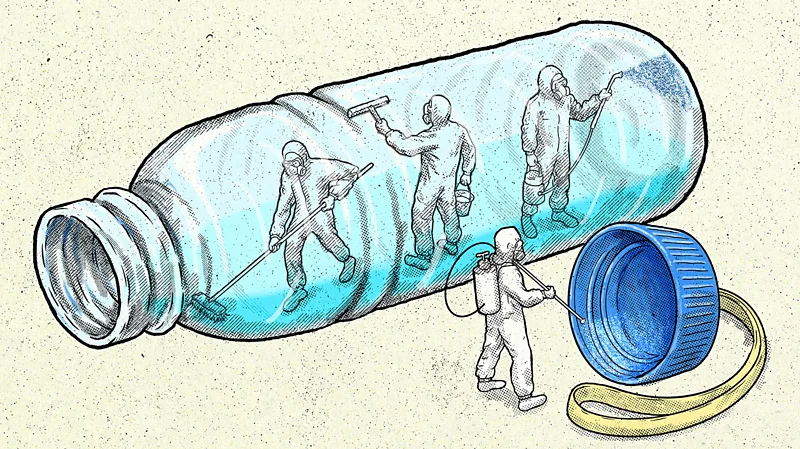Every time you take a sip from your water bottle, you’re depositing bacteria inside, and over the course of a day, these can multiply by the millions. Here’s what scientists say you can do about it.
Carl Behnke had always wondered how clean his reusable water bottle was. When he stuffed some paper towels inside and swirled them around, he was in for a shock.
“The towels were white – until I pulled them out,” says Behnke, an expert in food safety at Purdue University in Indiana, US. “I realized that the slippery sensation I felt in the interior of the bottle was not because of the material but rather because of a bacterial build-up.”
His next step was to design a study. Behnke and colleagues stopped passers-by in a corridor at Purdue and asked if they would be willing to loan their water bottles to them as part of their research – to see how clean they were.
“One thing that stood out from the project was the number of people who didn’t want to know the results,” recalls Behnke. “Basically, they knew that their cleaning habits were poor to non-existent – something the data later confirmed.” The results confirmed that those bottles were teeming with bacteria.
The global reusable water bottle market was worth around $10 billion (£7.7 billion) in 2024. One study on Italian healthcare workers suggested that half of them used reusable bottles, while research involving university students suggests somewhere between 50% and 81% of participants used these drinking vessels.
But while they help people stay hydrated, drinking from water bottles regularly, and taking them with us everywhere we go, may also pose health risks. So, should we ditch them, or can those risks be managed?
What Exactly Is Inside Reusable Water Bottles?
While it’s usually safe to drink, water from our kitchen taps is not devoid of microbial life. This is why leaving water in your bottle for a few days will encourage bacteria to grow, says Primrose Freestone, associate professor in clinical microbiology at the University of Leicester, in the UK.
Bacteria that can cause human infections thrive at around 37°C (98°F), Freestone says, but can also multiply at room temperature, around 20°C (68°F).
“The longer water in a bottle is stored at room temperature, the more bacteria will grow,” she says.
One study conducted in Singapore using boiled tap water – which should have killed most bacteria in it – found that bacteria populations can grow rapidly inside water bottles as they are used throughout the day. On average, they found that water inside bottles used by adults went from having around 75,000 bacteria per milliliter in mid-morning to more than 1-2 million per milliliter over the course of 24 hours.
Gorka Olmo
Every sip you take from a water bottle or even a glass can leave microbes behind that mingle with those already in the liquid (Credit: Gorka Olmo)
One way to slow bacterial growth down is to store your bottle in the fridge between sips, Freestone says, though this doesn’t stop it from growing altogether.
But while some of a water bottle’s bacterial activity comes from the water itself, most contamination is actually introduced by the drinker. Whether you take your bottle to work, the gym, or even just keep it in the house, the outside of your bottle will carry many microbes. And these microbes are easily transferred into the contents of the bottle, along with bacteria from your mouth every time you take a sip, Freestone says.
Water bottle users who don’t wash their hands regularly will also find that their bottles can harbor bacteria such as E. coli, Freestone says.
“Poo-associated bacteria, such as E. coli, can come from our hands and end up on our lips if we’re not good at toilet hygiene,” she says.
And we can pass on, or catch, viruses by sharing water bottles with others. Diseases such as norovirus could easily be passed on in this way.
People generally have between 500 and 600 different species of bacteria living in their mouths, says Freestone. “What isn’t necessarily disease-causing for you isn’t always the case for others. You can carry an infection and not realize it, because our immune systems are so good at protecting us,” she adds.
Another way you can encourage bacterial growth in your bottle is by putting anything other than fresh water in them. Drinks that nourish you also feed microbes – so any drinks containing sugar, for example, can stimulate the growth of any bacteria or mold present in your bottle, Freestone says.
“Anything other than water is heaven for bacteria and fungi, especially protein shakes,” she says.
If you’ve ever left milk in a glass for a few hours, you may have noticed that it leaves behind a thin film on the glass when you pour it away. Bacteria happen to adore this film, Freestone says.
How Can This Bacteria Affect Us?
We are all surrounded by bacteria in the soil, air, and on our bodies, but it’s worth remembering that most bacteria are harmless or even beneficial.
Water that’s been contaminated with bacteria such as E. coli can cause diarrhea and vomiting, but not all the time. E. coli are a large group of bacteria found naturally in the environment but also are common natural inhabitants of the human gut. It is only when the bacteria turn pathogenic – in other words, they pick up certain traits that make them harmful – that they make people ill.
Behnke and his colleagues also suggest using a dishwasher with a sanitization cycle could be the most effective approach.
Most microbes aren’t harmful to humans, but people whose immune systems are impaired can be more prone to infections, Freestone says.
Also, getting sick with a stomach bug can, in some cases, lead to long-term changes in the gut.
“Our guts are changing all the time, but there are over 1,000 species present in the gut, so it’s hard to shift in terms of composition,” says Freestone. “There are too many variables to say, but getting food poisoning from the bacteria in a water bottle will never lead to a positive change.”
People who’ve recently taken antibiotics that can affect their gut microbiome can also experience changes that leave them more vulnerable to other infections. One swab of a reusable water bottle taken at a newspaper office in the UK also revealed that these bottles can be a breeding ground for emerging strains of antibiotic-resistant bacteria. Researchers discovered a species of bacteria called Klebsiella grimontii – which is capable of forming biofilms on otherwise sterile surfaces – in the sample taken from the water bottle. While it can be found as part of the normal microflora of the gastrointestinal tract, it can also cause severe diarrhea in people who have recently taken antibiotics.
More like this:
• Your kitchen sponge teems with bacteria – is it better to use a brush?
• Are you pooing often enough?
• What your fingernails can reveal about your health
If mold or fungi grow in your bottle, this can trigger symptoms in anyone with allergies.
It’s worth noting, however, there are no examples of severe illness that have been traced back to reusable water bottles in the scientific literature. This doesn’t mean they don’t happen, of course, as identifying single point sources of infection is notoriously difficult.
How Should We Clean Reusable Bottles?
For Behnke, it was the creeping sense that he should perhaps be cleaning his own water bottle more thoroughly that made him look closer at what could be inside it. He’d been using a filtered water bottle and had started to notice that the water he was drinking from it tasted bad.
“Every now and then, I would flush it with hot water, but never really did anything more than that,” he says.
After his paper towel-based investigations revealed how dirty his water bottle was, the study he and colleagues carried out went on to look at people’s water bottle habits in greater detail.
Behnke found that just over half of the 90 participants surveyed during the research said they share their bottle with others, and 15% said they never cleaned their bottles. Unsurprisingly, whether or not people rinsed or washed their water bottles affected the contamination level. However, Behnke found that how often they cleaned the bottles, or how they cleaned them, didn’t enormously affect how contaminated the containers were.
People who washed their bottle with tools such as a brush or used a dishwasher tended to have the lowest counts of bacteria inside. Behnke and his colleagues also suggest using a dishwasher with a sanitization cycle could be the most effective approach.
However, the study’s conclusion states that these findings may have been skewed by the fact the researchers were relying on participants self-reporting their cleaning behaviors, and they may have changed their answers to appear more socially acceptable.
The study also found that bottles containing tea, coffee, or juice were more contaminated than bottles that only contained water.
Gorka Olmo
Storing your water bottle in the fridge between sips can be one way to slow down microbial growth (Credit: Gorka Olmo)
Cleaning our water bottles regularly and properly is the only way to be confident you are not consuming harmful bacteria alongside your water. Even if the water inside it is sterile, Freestone says, your saliva will end up in the bottle, along with trace levels of nutrients, which bacteria happily feed on.
Rinsing your bottle out with cold water isn’



